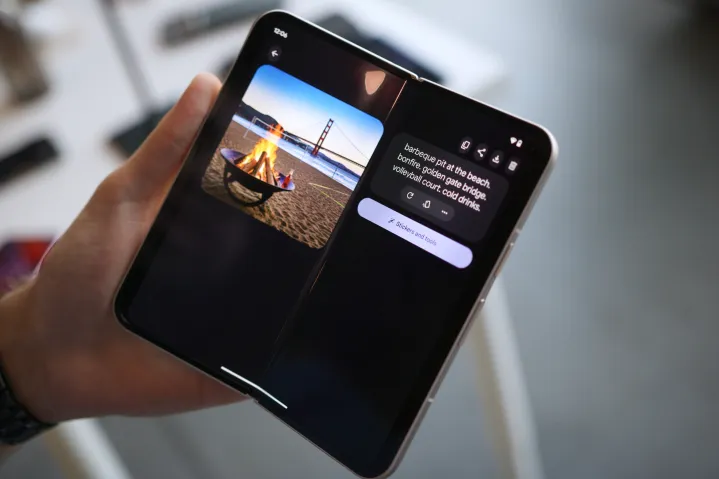This Samsung Galaxy Z Fold 6 and Google Pixel 9 Pro Fold battle pits a sixth-generation device against a second-gen device — and the winner would seem obvious. After all, a company should have an edge if it has been building foldables for six years while the other phone manufacturer is only two years in.
But it’s not that simple, as these two are the exact opposite in terms of generational upgrades. While Samsung pushed out an iterative upgrade, Google went back to the design board and changed the foldable’s form factor. Google seems to have already perfected its design language with the Pixel 9 Pro Fold, whereas Samsung’s complacency this year makes it look like it’s falling behind in the foldable phone segment. However, it’s not a complete slam dunk for Google, as the Korean company added a bunch of meaningful upgrades over the Galaxy Z Fold 5. So, which should you buy?
If you’re in the market for a book-style foldable, here’s what you need to know about the latest foldables from Google and Samsung.
Google Pixel 9 Pro Fold vs. Samsung Galaxy Z Fold 6: specs
| Google Pixel 9 Pro Fold | Samsung Galaxy Z Fold 6 | |
| Size | Folded: 155.2 x 77.1 x 10.5 mm
Unfolded: 155.2 x 150.2 x 5.1 mm |
Folded: 68.1 x 153.5 x 12.1mm
Unfolded: 132.6 x 153.5 x 5.6mm |
| Weight | 257 grams | 239 grams |
| Colors | Obsidian
Porcelain |
Silver Shadow
Pink Navy Crafted Black (online exclusive) Purity White (online exclusive) |
| Displays | 6.3-inch OLED (2424 x 1080) cover display with 20:9 aspect ratio
8-inch OLED (2152 x 2076) main display Up to 120Hz refresh rate for both Corning Gorilla Glass Victus 2 Up to 2,700 nits (peak brightness) |
6.3-inch HD+ AMOLED (2376 x 968) cover display with 22.1:9 aspect ratio
7.6-inch OLED (2208 x 1840) main display Up to 120Hz refresh rate for both Corning Gorilla Glass Victus 2 Up to 2,600 nits (peak brightness) |
| Chipset | Google Tensor G4
Titan M2 security coprocessor |
Qualcomm Snapdragon 8 Gen 3 for Galaxy |
| RAM | 16GB | 12GB |
| Storage | 256GB or 512GB | 256GB or 512GB or 1TB |
| Rear cameras | 48-megapixel wide camera
10.5MP ultrawide 10.8MP telephoto with 5x optical zoom |
50MP main
12MP ultrawide 10MP telephoto with 3x optical zoom |
| Selfie cameras | 10MP front camera
10MP inner camera |
10MP with front display
4MP inner under-display camera |
| Battery | 4,650 mAh | 4,400mAh |
| Charging | Fast charging up to 45W
Wireless charging, Qi-certified |
25W fast charging
15W wireless charging 4.5W reverse wireless charging |
| Software and Updates | Ships with Android 14
Seven years of OS, security, and Pixel Drop updates |
Ships with Seven years of OS and security updates |
| Price | From $1,799 | From $1,899 |
Google Pixel 9 Pro Fold vs. Samsung Galaxy Z Fold 6: design and display

The Google Pixel 9 Pro Fold is a departure for the brand, and moves from the squat, passport-like design of the Pixel Fold to a more regular smartphone-like shape when folded. By contrast, Samsung is sticking to its slim cover screen on the Galaxy Z Fold 6. A slight bump of 0.1mm in screen size has made typing easier, and the screen is now more usable than before.
The Pixel 9 Pro Fold weighs 257 grams (down from 283 grams), while the Galaxy Z Fold 6 measures 239 grams (down from 253 grams) on the weighing scale. The Samsung foldable is easier to handle than before and it feels great in the hand. The Pixel 9 Pro is likely to feel comfortable in the hand, thanks to the curved corners. However, the Samsung foldable has sharp corners, especially on the hinge side, which makes it feel pointy in the left palm. The Pixel 9 Pro Fold may to be better in this regard.
Samsung’s hinge is tight and the phone stays put at the angle you want it to. The Google foldable features an improved hinge mechanism and can now lie flat on the table. As noted in our Pixel Pro 9 Fold hands-on, opening the phone is far smoother than before.

The border on the left side of the Pixel 9 Pro Fold gives away the fact that it’s a second-generation foldable. The Galaxy Z Fold 6 looks more polished in this regard. Moreover, Samsung is the first company to introduce dust resistance on its foldable phone. The Galaxy Z Fold 6 is rated IP48 dust and water resistance, while the Pixel foldable is rated IPX8 for water resistance. You’re still not recommended to take these phones to the beach, but it’s comforting to know that these foldables are protected.
The Google Pixel 9 Pro Fold features a 6.3-inch OLED front display with support for a dynamic 120Hz refresh rate, while the Galaxy Z Fold 6 comes equipped with a 6.3-inch 120Hz AMOLED with cover screen. The Pixel is brighter at 2,700 nits peak brightness versus 2,600 nits on the Galaxy. Both the screens are sharp and vivid.
As for the inner screen, the Pixel 9 Pro Fold sports an 8-inch LTPO OLED display with a 1-120Hz variable refresh rate and 2,700 nits peak brightness. On the other hand, the Galaxy Z Fold 6 comes with a 7.6-inch AMOLED folding screen with the same 1-120Hz variable refresh rate and lower 2,600 nits brightness. Both displays feature minimal crease. The Samsung foldable one-ups the Pixel with S Pen support. But you’ll need an additional case to use the stylus since there is no built-in slot for the same.
With a better cover screen aspect ratio and an LTPO OLED panel, the Pixel 9 Pro Fold is the winner, despite the Galaxy Z Fold 6 offering a lighter design with dust resistance rating.
Winner: Google Pixel 9 Pro Fold
Google Pixel 9 Pro Fold vs. Samsung Galaxy Z Fold 6: performance and battery

The Pixel 9 Pro Fold is powered by the Google Tensor G4 chipset, paired with 16GB of
By contrast, the Galaxy Z Fold 6 uses the Qualcomm Snapdragon 8 Gen 8 processor with 12GB of
The Samsung foldable comes with a 4,400mAh battery with fast charging support. It gives a day’s worth of usage on a single charge consistently — when not pushed with navigation and camera usage. Both phones charge comparatively slowly, and don’t support superfast charging like the OnePlus Open. But the Pixel 9 Pro Fold still charges at a faster and more respectable rate of 45W.
However, the battery in the Pixel 9 Pro Fold isn’t as efficient with screen time as the Galaxy Z Fold 6’s battery. The juice decreases 6% per 30 minutes spent watching YouTube or Netflix, or playing any of your favorite mobile games. Clearly, the Samsung Galaxy Z Fold wins in this department, especially if you watch videos and play games on the go more frequently than you do at home.
Winner: Samsung Galaxy Z Fold 6
Google Pixel 9 Pro Fold vs. Samsung Galaxy Z Fold 6: cameras

The Google Pixel 9 Pro Fold sports a triple rear camera setup. You get a 48-megapixel primary camera, 10.5MP ultrawide lens, and 10.8MP telephoto camera with 5x optical zoom. The smartphone comes with an additional feature called Made You Look, which displays an animation on the outer display to grab the attention of hyperactive kids and keep them still for photos.
The Galaxy Z Fold 6 also holds three cameras on the back. There’s a 50MP primary camera, a 12MP ultrawide-angle lens, and a 10MP telephoto camera with 3x optical zoom. In general, the telephoto camera was weak, and it’s disappointing that Samsung didn’t upgrade it this year. The other two sensors did a fine job, but they struggle with clicking photos of moving subjects. Plus, the lowlight camera performance is average, too.
The Galaxy Z Fold 6 features a 4MP under-display camera (it isn’t very good) inside the folding screen, which makes for an uninterrupted experience to read and view full-screen photos. The Google phone comes with two 10MP selfie shooters on both displays, but it’s always recommended to use the primary cameras for taking selfies on foldables.
Meanwhile, the Google Pixel 9 Pro Fold’s camera strikes a perfect balance between color and contrast, no matter what the lighting situation is when you take photos. You can even take good close-up pictures of certain subjects, like various insects, with macro mode, which gives the pictures a much higher quality than if that feature wasn’t there to spice up your ultra zoomed-in photos. Whatever unwanted item or person appears in the background of your photos, you can remove it with Magic Editor so that your pictures can appear flawless.
Both of these foldables have slightly toned-down versions of their respective flagship phones’ camera suites, and both are excellent and hard to pick between. This is a tie.
Winner: Tie
Google Pixel 9 Pro Fold vs. Samsung Galaxy Z Fold 6: software and updates

Both the Google Pixel 9 Pro and Galaxy Z Fold 6 come with
The Google Pixel 9 Pro Fold offers a bunch of Gemini-powered AI features. There’s a new Add Me mode in the Camera app, which makes clicking group photos without missing anybody easier than ever. You can click a group photo, exchange the camera with another person from the group while they click another shot of the group (this time with you present) and Add Me merges the two photos to include everyone. You get the usual Photos AI features like Magic Editor, Magic Eraser, and more as well.
The Galaxy Z Fold 6 features Galaxy AI, which offers features such as Portrait Studio and Sketch to Image. The former lets you transform selfies into 3D cartoons, sketches, and more, while the latter generates images based on your rough sketches. Both phones offer an AI feature called Circle to Search that puts Google Lens search at your fingertips.
Samsung’s One UI is smooth and more feature-rich than the Pixel UI on the Google foldable. Both the phones feature the same number of OS support years and party-trick AI features (a few useful ones, too), which depends on how frequently you use them. It’s a tie.
Winner: Tie
Google Pixel 9 Pro Fold vs. Samsung Galaxy Z Fold 6: price and availability

The Google Pixel 9 Pro Fold is available now, starting at $1,799, and only comes in two colors: Obsidian and Porcelain. In comparison, Samsung increased the price of the Galaxy Z Fold 6 by $100 this year, and it now starts at $1,899 for the base 256GB variant, which is more expensive than the Pixel 9 Pro Fold.
Google Pixel 9 Pro Fold vs. Samsung Galaxy Z Fold 6: Which one should you buy?

Google seems to have perfected the foldable form factor with its Pixel 9 Pro Fold. The
On the other hand, the Samsung Galaxy Z Fold 6 adds subtle refinements to be a meaningful upgrade. You get dust resistance, S Pen support, tried and tested Samsung foldable software, and a powerful and efficient processor. But it’s $100 more for the same 256GB of base storage.
Google beats Samsung in terms of usability on the cover screen, while Samsung offers a robust foldable experience. The cameras are equally as fantastic, and hard to pull apart. Honestly, it’s hard to pick between these two where this comparison is concerned, and that’s an incredible feat as far as Google is concerned. In just two generations, Google has managed to catch up with Samsung’s enormous lead, and that’s just impressive by itself. Either of these two foldable phones is a great purchase, so we recommend you check them out in person and go for whichever feels the best in your hand.


